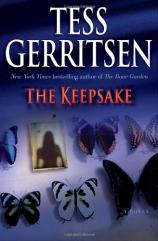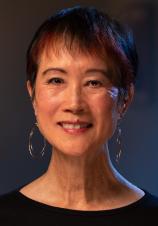Interview: September 12, 2008
September 12, 2008
Tess Gerritsen's latest novel, THE KEEPSAKE, marks the return of Dr. Maura Isles and Detective Jane Rizzoli, who investigate a series of present-day murders in which the victims are subjected to ancient methods of burial and preservation.
In this interview with Bookreporter.com's Joe Hartlaub, Gerritsen explains how she first became fascinated with archaeology and discusses the real-life inspiration behind her eccentric characters and chaotic settings. She also offers words of advice for first-time writers and speculates on the future of her protagonists in upcoming series installments.
Bookreporter.com: THE KEEPSAKE may be your most chilling novel to date. It begins with the discovery of what is believed to be a mummy --- dubbed “Madam X” --- that actually turns out to be the preserved body of a long-missing woman. As more bodies are discovered, preserved in similarly unusual and grisly circumstances, Dr. Maura Isles and Boston homicide detective Jane Rizzoli attempt to uncover the link among them and the ultimate motive for these crimes. Did you base THE KEEPSAKE on a “true crime?” If not, what was your inspiration?
Tess Gerritsen: THE KEEPSAKE was based on my own fascination with Egyptian mummies and other bizarre ancient death rituals from around the world. I'd read about Egyptologist Bob Brier's experience of mummifying a modern cadaver. When he'd completed the process, the mummy looked very much like an ancient specimen. I'd also been corresponding with an Egyptologist who has been studying mummies using modern CT-scanning techniques, and I wondered: what if a CT scan of an "ancient" mummy turns up a shocking surprise? What if the dead woman is a far more recent murder victim? It allowed me to delve into macabre facts from the archaeological world.
BRC: How did you research ancient and primitive burial practices, particularly bog preservation, that figure so prominently in THE KEEPSAKE?
TG: I have an extensive home library that's focused on just such interesting subjects. It includes shelves and shelves of Egyptology books, plus books on bog bodies, mummies and shrunken heads. I started my research with textbooks and have also visited the British Museum at least half a dozen times. New England (where I live) happens to have a number of bogs, so we also have our own local experts on bog biology and I was able to draw from some of their published research.
BRC: The background story in THE KEEPSAKE indicates that you have more than a passing interest, and familiarity, with archaeology. Has this been a long-time interest of yours, or something that you came to more recently? How did you initially become interested in this? Do you have any thoughts on what might be the most significant archaeological discovery of the past 10 years?
TG: I was an anthropology major in college. My senior project involved the examination and cataloguing of human remains found in North American burial sites, so I spent many lonely hours in the basement of the Stanford University Museum, surrounded by boxes of bones. Although I subsequently went on to become a medical doctor, I've never lost my fascination for all things archaeological. As for the most significant discovery of the past 10 years, I know I'm going to get into trouble with Biblical archaeologists for saying this, but I have been utterly fascinated by the Talpiot tomb, which contained a number of ossuaries bearing inscriptions with the names of Jesus's immediate family. Although the tomb was discovered in the 1980s, only recently has anyone really tried to analyze the tomb findings --- so I suppose that qualifies as a "rediscovery" within the past 10 years. The question of whether that particular cluster of names is significant --- or merely coincidence --- will probably never be answered. Still, it was enough to shake up the Biblical archaeology world.
BRC: Some of the more eccentric characters in THE KEEPSAKE seem amazingly true to life. Are they based after real-world models?
TG: I confess, I often use eccentric people I meet in real life as models for my characters. Perhaps that's why they seem real!
BRC: The Crispin Museum, which figures so prominently in the book, is quite an interesting place, a disorganized, poorly catalogued and maintained collection that nonetheless contains some fascinating specimens. In THE KEEPSAKE, it is located in Boston. Did you create it specifically for the novel, or does a similar place actually exist?
TG: Several archaeologists have told me that museums are often disorganized institutions where items can get lost over the decades. We may be talking about collections that are over a hundred years old, and during that time curators retire or die, and information doesn't get passed on to the next generation. Records and field notes are lost and no one recalls just what's in all those boxes. That last scene in the first Indiana Jones movie, showing a government warehouse filled with forgotten crates, is not all that far from the truth. The Crispin Museum isn't a real place, but it has the characteristics of many an old private museum that's fallen onto hard financial times.
BRC: In THE KEEPSAKE, readers see the return of Anthony Sansone from THE MEPHISTO CLUB. Do you see Sansone playing a more prominent role in your novels in the future? And do you have any plans at this point to perhaps begin a second series of books featuring Sansone and/or the Mephisto Club?
TG: I was fascinated by Sansone in THE MEPHISTO CLUB, and I wanted to see him back onstage in the series. His arcane knowledge of evil and Satanism makes him both a mysterious and somewhat frightening character. So yes, I do see him playing a prominent role in books to come, as another temptation for Maura, but perhaps also as the core of a spin-off series featuring the work of the mysterious Mephisto Club.
BRC: On a related note, the ongoing romance between Maura Isles and Father Daniel Brophy continues in THE KEEPSAKE. What prompted you to start this plot thread in one of the earlier books? And do I sense, perhaps, a triangle forming, with a potential relationship blooming between Maura Isles and Anthony Sansone?
TG: These subplots always seem to start all on their own, without any planning on my part! Maura Isles is a brilliant woman who seems to have it all, but underneath she's lonely and she makes some of the same romantic mistakes that many other intelligent women make. She's fallen in love with an unattainable man. In THE KEEPSAKE, Maura is coming to the realization that her love affair with Daniel may be a dead-end relationship, yet she's having trouble making a decision to break it off. I do think that a triangle could be forming, because Sansone is so darn fascinating --- and a little scary at the same time.
BRC: Writing is said to be a solitary act, yet many authors have a de facto team of “go-to folks” who are the first readers --- “after the author and before the editor” --- to see the manuscript. Did you vet THE KEEPSAKE with others while you were writing it? If so, can you share with us what some of the early feedback was and how it influenced the final manuscript?
TG: I don't vet my manuscripts with anyone until it's in final form. When I think it's polished to the point of being publishable, I send it simultaneously to my editor and agent. At the same time, my husband reads it for typos (he's good at catching those). I've always worked this way, and in some ways I feel that showing a manuscript to someone before it's ready places a jinx on it!
BRC: THE KEEPSAKE, from first page to last, is primarily a thriller, yet there is also a tantalizing mystery --- or two --- at its core. What mystery authors do you feel have most influenced your work?
TG: I'm a big fan of science-based thrillers, and writers like Michael Crichton and Aaron Elkins really showed me how to weave in facts with the thrills. I also have to give a nod to writers that inspired me early on --- Stephen King for his character development, and Patricia Cornwell for demonstrating that a book can be graphic and fascinating without being gratuitously violent.
BRC: Some of our readers may be in the process of writing their first novel. What advice would you give them? Is there anything that you wished you had done differently when you were starting out? And what do you think was the best thing that you did at the beginning?
TG: I would advise them to write the first draft all the way to the end, without any attempts at revising. Too many first-time authors get stuck with repeated revisions of the first few chapters, and they never get beyond it. I find that I don't know what my book is about until I finish the first draft. Only then do I go back and start revising, because only then do I know what needs to be fixed. I wish I had known this when I was just starting out. I ended up writing a number of partial novels that were never finished because they seemed so utterly wretched halfway through. I've since learned that first drafts are always wretched --- and that you just have to ignore their defects and forge ahead. Because they can be fixed.
BRC: What are you presently working on? Do you work on one novel at a time, or are you constantly writing a number of works as they proceed in various stages?
TG: At the moment I'm taking a much-needed sabbatical and mentally preparing myself for a very long book tour. I've written a few chapters of a fun project, something I won't be showing to anyone for a while. When it's further along, maybe I'll be ready to talk about it!




